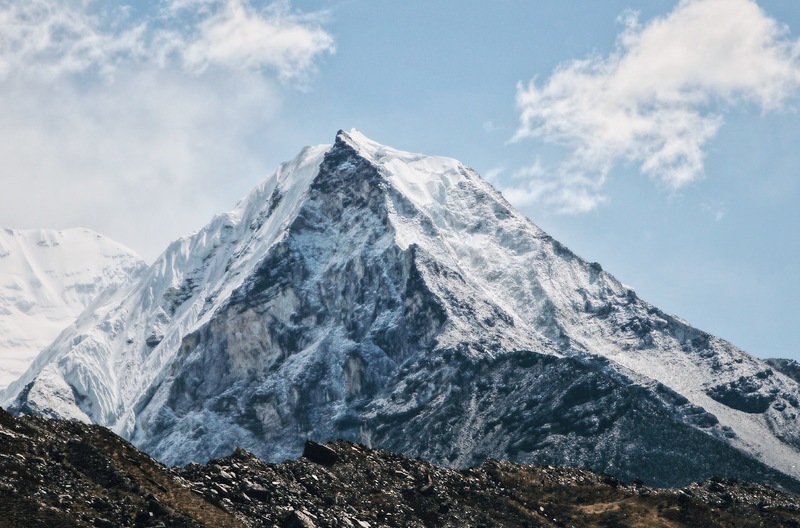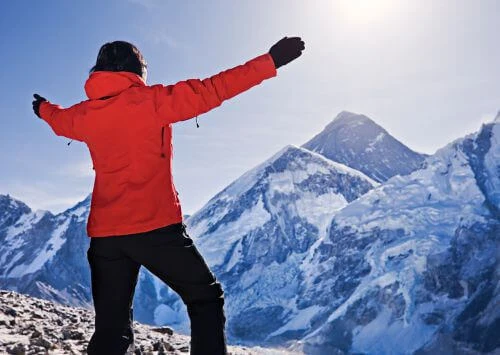History and Significance of Island Peak
Island Peak, located in the Khumbu region of Nepal, has a rich history that dates back to the early days of Himalayan exploration. Named "Island Peak" by Eric Shipton's party in 1951, the peak earned its name due to its striking resemblance to an island in a sea of ice when viewed from Dingboche. However, the local Sherpa community refers to it as "Imja Tse," which translates to "Island Peak" in the Sherpa language.
Beyond its captivating name, Island Peak holds immense significance for mountaineers. It is an ideal stepping stone for aspiring climbers who wish to test their skills and acclimate themselves to higher altitudes before attempting more challenging peaks, such as Mount Everest. Island Peak also offers a mesmerizing vantage point where climbers can witness the grandeur of the surrounding mountains, including Lhotse, Nuptse, and Ama Dablam making it a key destination for peak climbing in Nepal.
To preserve this pristine environment, the Nepal Mountaineering Association requires climbers to obtain a permit for Island Peak. This measure helps regulate the number of climbers and maintain the region's sustainability.
Preparation and Training for Island Peak Climbing.
Island Peak climbing demands thorough preparation and training to ensure a safe and successful ascent. Aspiring climbers should focus on building their endurance, strength, and technical skills to tackle the challenges that lie ahead.
Physical fitness is paramount for any mountaineering expedition. Regular aerobic exercises such as running, cycling, and hiking can help improve cardiovascular endurance and prepare the body for the strenuous demands of high-altitude climbing. Strength training exercises targeting the core, legs, and upper body are essential to handle the steep and icy terrain.
In addition to physical fitness, climbers must develop technical skills such as bare rock climbing, ice climbing, and glacier travel techniques. These skills are crucial for navigating the challenging sections of Island Peak, including the rock gully, ice wall, and summit ridge. Joining a mountaineering course or hiring an experienced guide can provide valuable instruction and guidance in honing these skills.
Acclimatization is another crucial aspect of preparing for Island Peak climbing. Spending sufficient time at higher altitudes allows the body to adapt to reduced oxygen levels, reducing the risk of altitude sickness. Climbers often include acclimatization days during their trek to Island Peak Base Camp, allowing their bodies to adjust gradually to the increasing altitude. Hydration, proper nutrition, and adequate rest are vital for successful acclimatization.

Essential Gear and Equipment for Island Peak Climbing.
The right gear and equipment is essential for a safe and comfortable Island Peak Climbing experience. Being adequately prepared for the harsh mountain environment ensures climbers can focus on the ascent without unnecessary discomfort or risk.
Climbers should invest in high-quality mountaineering boots that provide excellent insulation, ankle support, and traction on icy surfaces. Crampons, ice axes, and harnesses are indispensable tools for navigating the glacier and ice sections of Island Peak. A helmet is also crucial for protection against falling rocks or ice.
Layering is key when it comes to clothing. Base layers of moisture-wicking material help regulate body temperature and keep climbers dry. Insulating layers, such as fleece or down jackets, provide warmth in colder conditions. A waterproof and windproof outer shell is essential to protect against unpredictable mountain weather. Additionally, gloves, hats, and neck gaiters help protect exposed extremities from frostbite.
Other essential items include a sturdy backpack, headlamp, sunglasses with UV protection, sunscreen, a sleeping bag suitable for sub-zero temperatures, and a lightweight and compact stove for melting snow and cooking meals at high altitudes.
Acclimatization and Altitude Sickness Prevention.
Acclimatization is vital for climbers attempting Island Peak, as the higher altitudes pose significant challenges to the human body. Altitude sickness, also known as Acute Mountain Sickness (AMS), can occur when ascending too quickly without allowing the body enough time to adapt to the reduced oxygen levels.
To mitigate the risk of altitude sickness, climbers should follow a gradual ascent profile with regular acclimatization days. These rest days allow the body to adjust to the increasing altitude and minimize the symptoms of AMS, such as headaches, nausea, and fatigue. Climbers should also prioritize hydration by drinking plenty of fluids and avoiding alcohol and caffeine, which can contribute to dehydration.
In severe cases of altitude sickness, climbers may require descent to lower altitudes or medical intervention. Recognizing the symptoms and communicating any concerns with the climbing team or expedition leader is crucial.
The Route and Challenges of Climbing Island Peak.
The Island Peak Climbing route typically starts with a scenic flight from Kathmandu to Lukla, followed by a trek through the heart of the Khumbu Region. The trail passes through picturesque Sherpa villages, lush rhododendron forests, and high-altitude barren landscapes before reaching Island Peak Base Camp.
From Base Camp, climbers proceed to High Camp, where they spend a night before attempting the summit. The ascent to the summit involves navigating a steep rock gully, followed by a challenging ice wall. The final section of the climb includes a narrow summit ridge, which requires careful footwork and the use of fixed ropes for safety.
Challenges during the climb include unpredictable weather conditions, extreme cold, high winds, and the technical difficulties of climbing on ice and mixed terrain. The physical and mental demands of ascending steep slopes at high altitudes can also be taxing, requiring climbers to pace themselves and conserve energy.
Accommodation Options and Logistics.
During the Island Peak climbing Expedition, climbers have various accommodation options along the trekking route. Teahouses, also known as lodges, are available in the villages, providing basic amenities such as a bed, meals, and hot showers. However, as climbers venture higher into the mountains, the availability of teahouses becomes limited.
At Island Peak Base Camp and High Camp, climbers typically set up tents for accommodation. Sufficient camping gear, including a sturdy tent, sleeping bag, and cooking equipment, is essential. Expedition teams often include Sherpa Guides, porters, and cooks who assist with setting up campsites and preparing meals.
Logistics play a vital role in a successful Island Peak climbing expedition. Obtaining climbing permits, arranging transportation, hiring experienced guides and porters, and managing food supplies require careful planning and coordination. Many climbers join organized expeditions or hire local trekking agencies to handle these logistics, ensuring a smooth and hassle-free experience.

Safety Measures and Precautions.
Safety should always be the top priority when embarking on an Island Peak Climbing Expedition. Climbers must be aware of the risks associated with high-altitude mountaineering and take necessary precautions to mitigate them.
Hiring an experienced and licensed guide is highly recommended. Guides possess valuable knowledge of the route, weather conditions, and emergency procedures. They can also provide guidance on proper climbing techniques and ensure climbers adhere to safety protocols.
Weather conditions in the mountains can change rapidly, so it is crucial to stay updated on weather forecasts and plan the climb accordingly. Climbers should carry essential safety equipment, including a first aid kit, emergency communication devices (such as a satellite phone or personal locator beacon), and extra food and water in case of unexpected delays.
Personal health and well-being are essential throughout the expedition. Regularly monitoring oxygen saturation levels using a pulse oximeter can help detect early signs of altitude sickness. Climbers should also listen to their bodies and communicate discomfort or symptoms to the expedition team.
Best Time to Climb Island Peak.
The best time to climb Island Peak is during the Pre-monsoon (Spring) and Post-Monsoon (Autumn) seasons. These seasons offer more stable weather conditions, clearer skies, and better visibility, increasing the chances of a successful summit.
During the Pre-Monsoon Season (April to May), climbers can experience pleasant temperatures and blooming rhododendron forests along the trekking trail. However, this period also saw higher traffic on the route, as many climbers attempted Everest and other regional peaks.
The Post-Monsoon Season (September to November) is another favorable period for Island Peak Climbing. The weather is generally dry, and the skies are clearer, providing stunning views of the surrounding peaks. The autumn season offers slightly cooler temperatures compared to the spring season.
Tips and Tricks for a Successful Island Peak Climb.
- Start training and preparing well in advance to build physical fitness and technical skills.
- Invest in high-quality gear and equipment to ensure climbing comfort and safety.
- Prioritize acclimatization and follow a gradual ascent profile to reduce the risk of altitude sickness.
- Stay hydrated and maintain a balanced diet throughout the expedition.
- Listen to your body and communicate any discomfort or symptoms to the expedition team.
- Be flexible and prepared for changes in the itinerary due to weather conditions.
- Respect the local culture and customs of the Sherpa communities you encounter along the way.
- Take time to appreciate the breathtaking landscapes and immerse yourself in the unique Himalayan Environment.
Conclusion: Fulfilling your Mountaineering Dreams on Island Peak.
Island Peak climbing offers an unparalleled adventure that combines the thrill of conquering a majestic peak with the awe-inspiring beauty of the Himalayas. From the history and significance of the peak to the preparation and training required, we have explored the key aspects of this mystique-filled expedition. With the necessary skills, gear, and knowledge, mountaineers can embark on a journey that pushes their limits, rewards their efforts, and leaves them with unforgettable memories.
The allure of Island Peak awaits those who dare to dream and rise to the challenge, promising an experience of a lifetime amidst the towering peaks and Sherpa culture of the Everest Region.
Explore our Peak Climbing in Nepal Packages
Cholatse Peak ClimbingLobuche and Island Peak Climbing
Mera Peak Climbing
Pokalde Peak Climbing
Yala Peak Climbing









